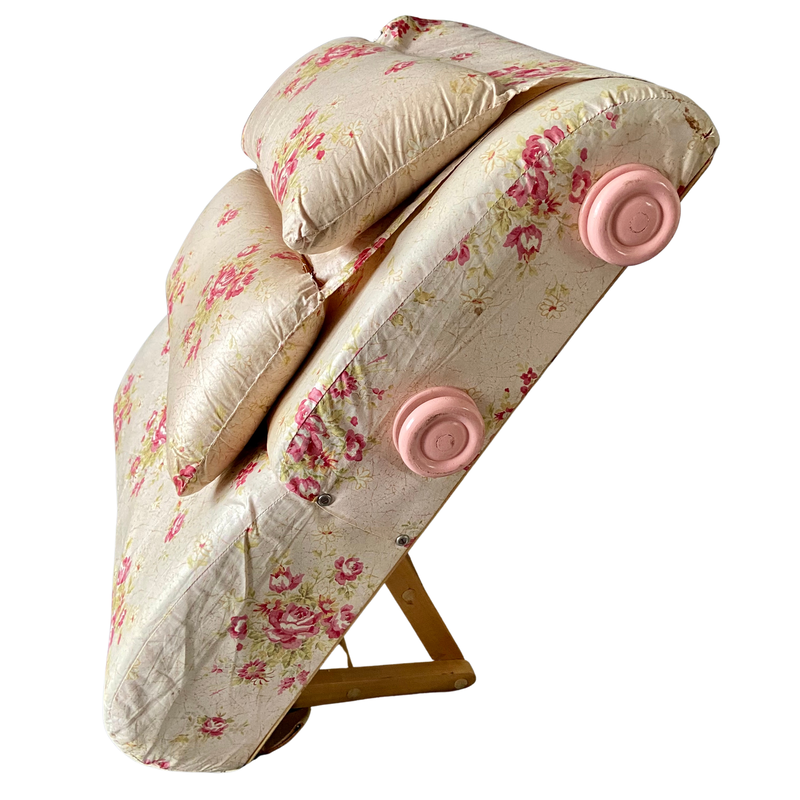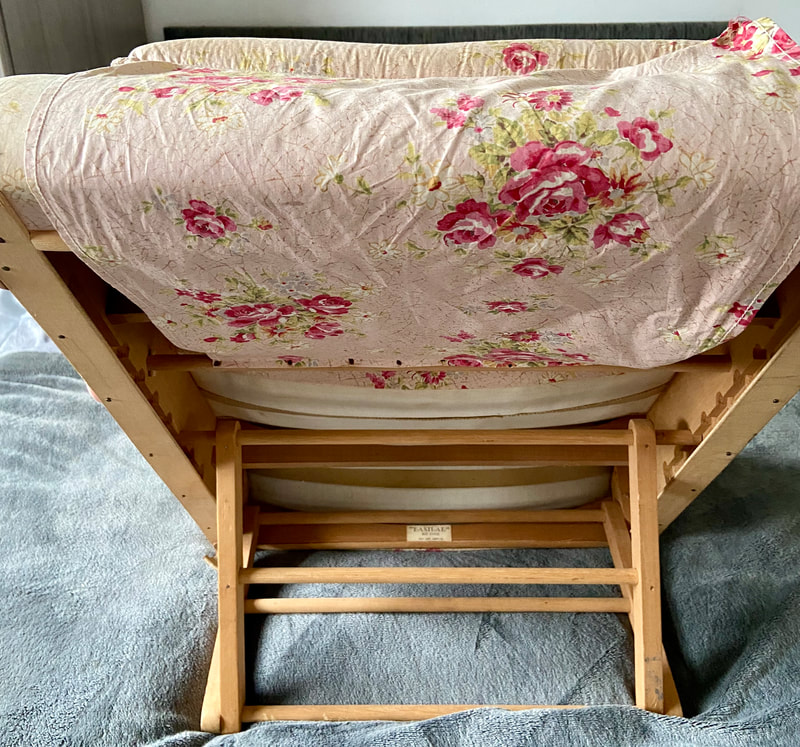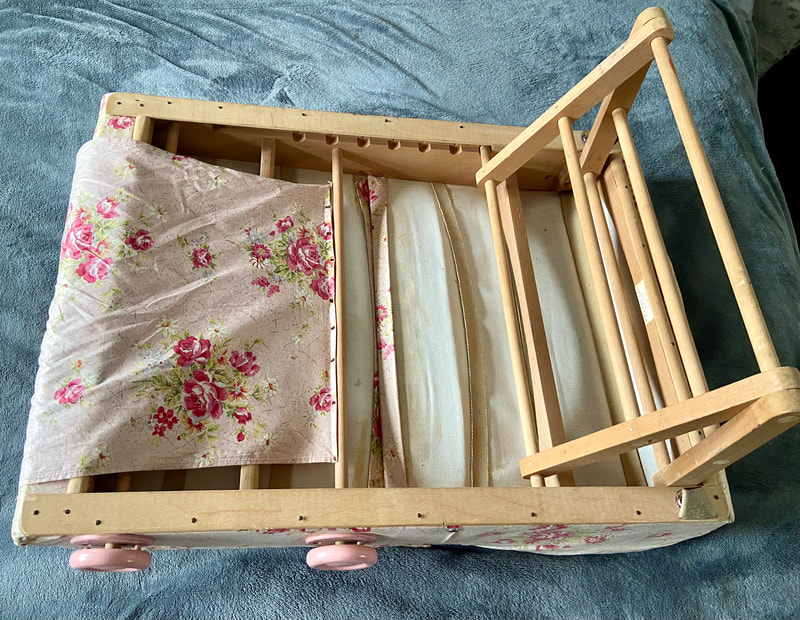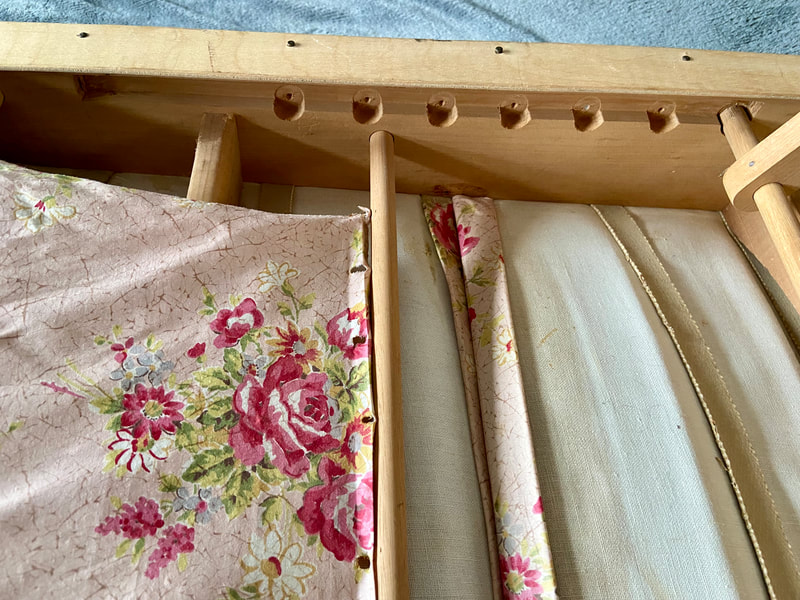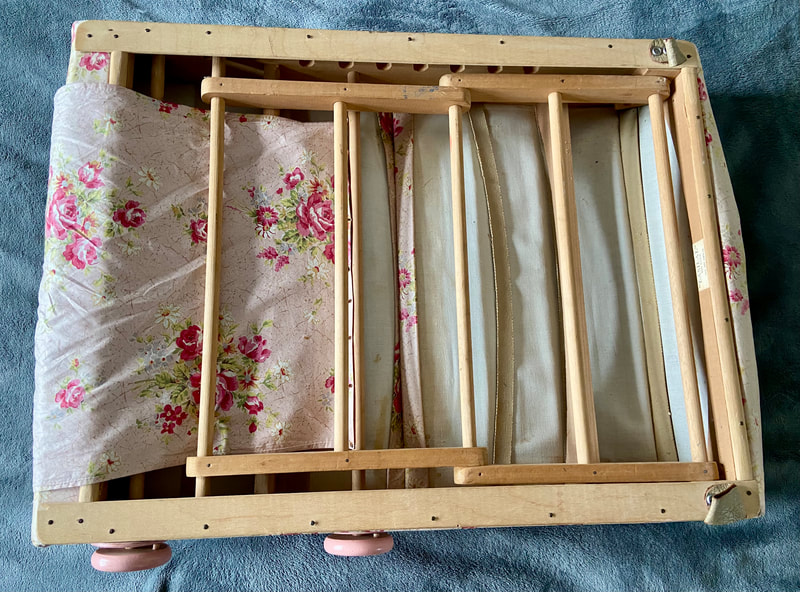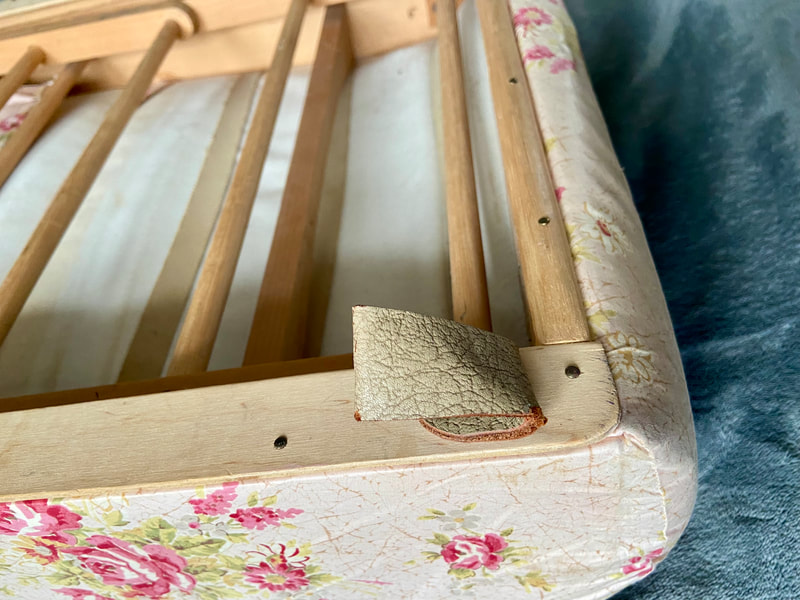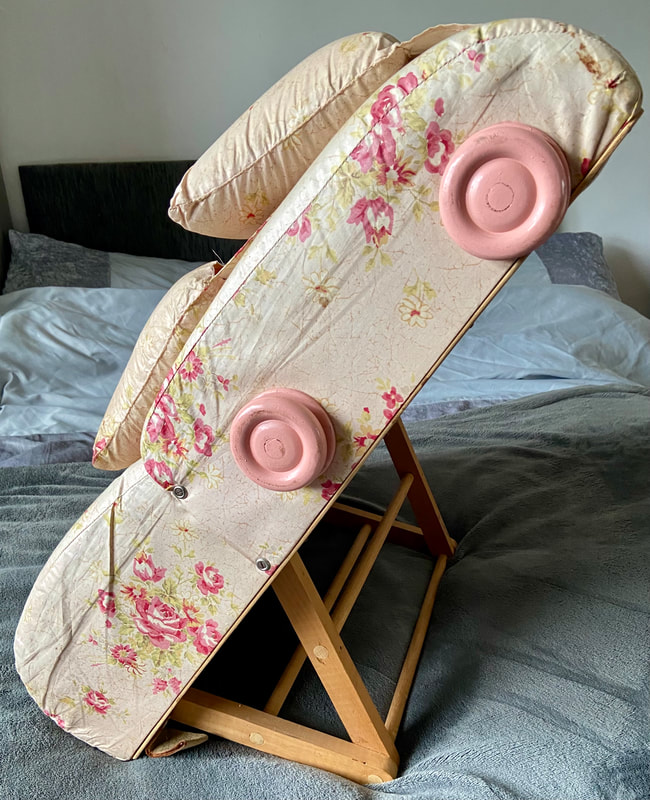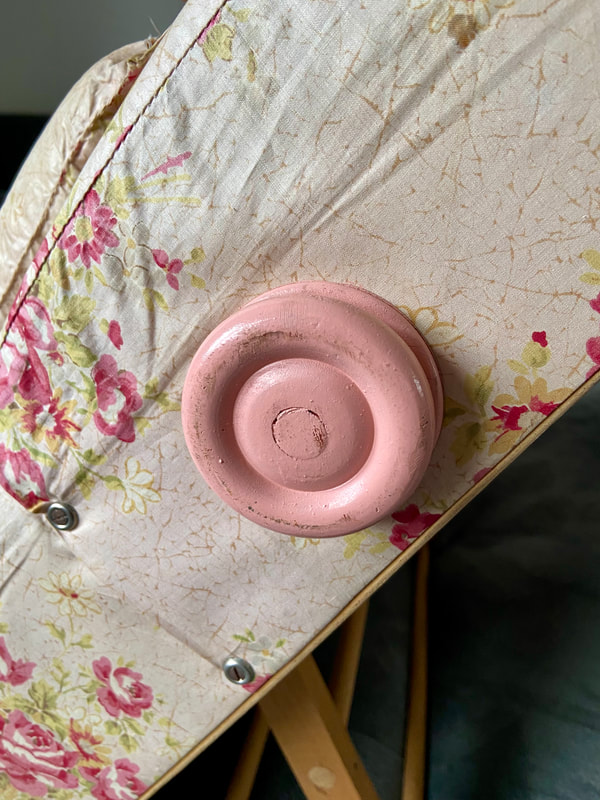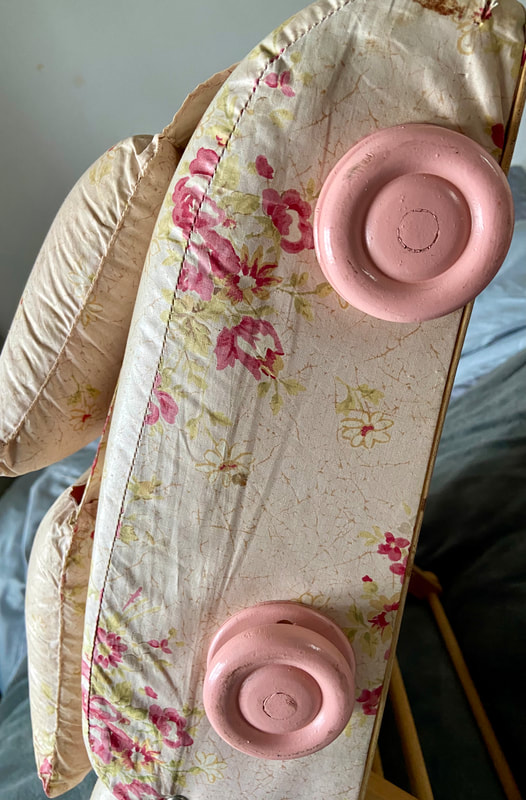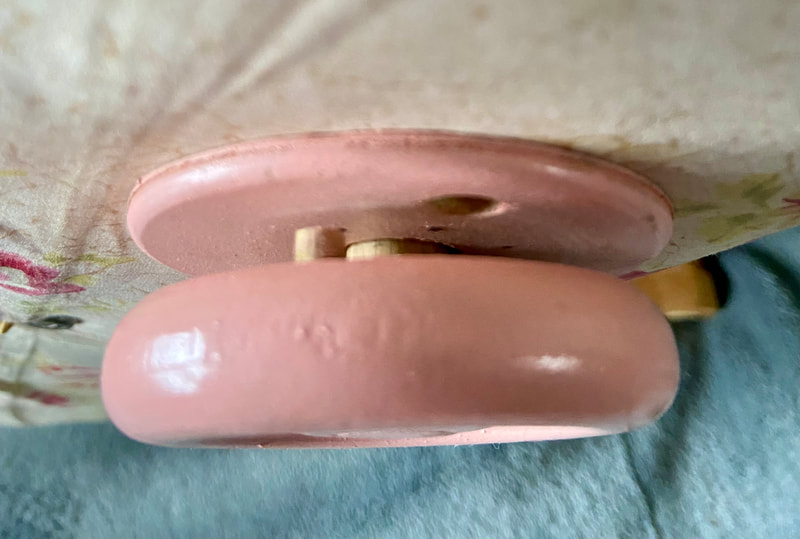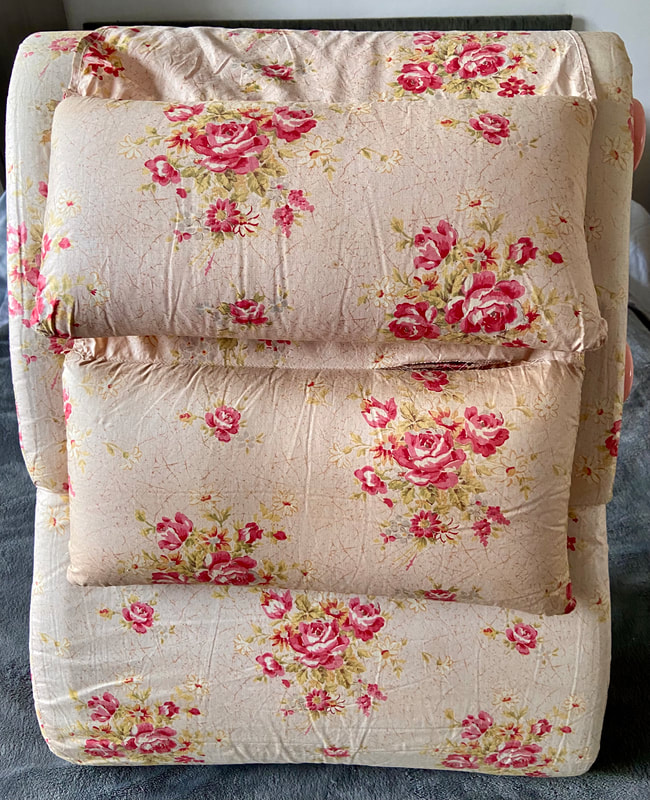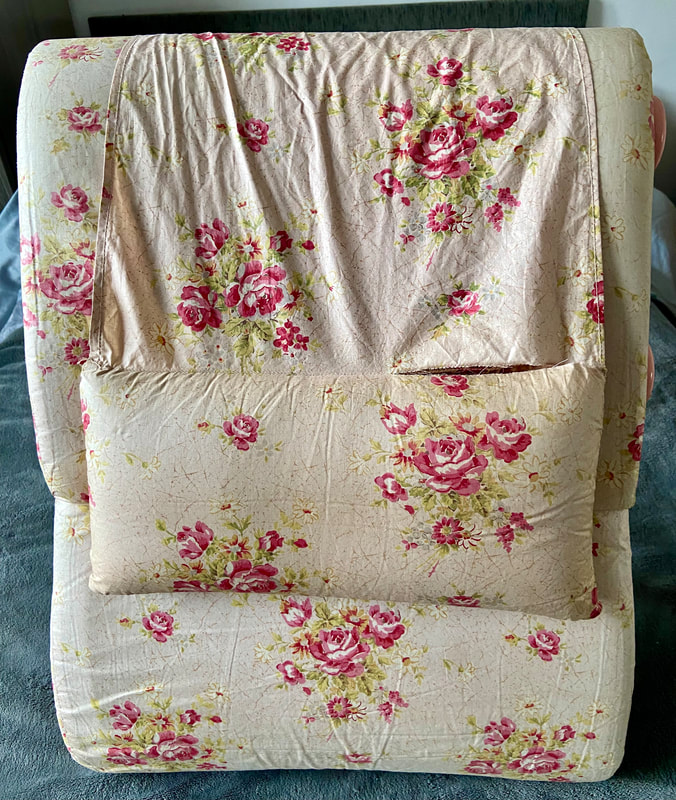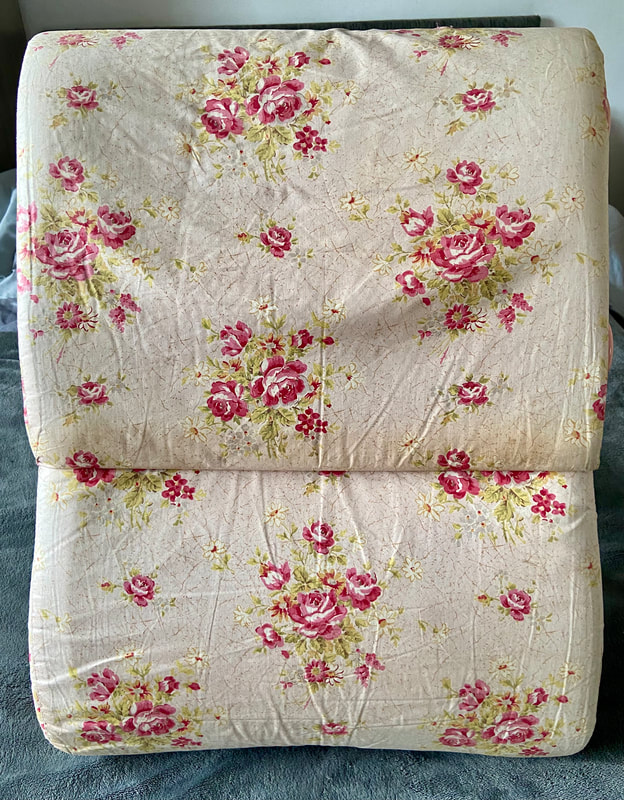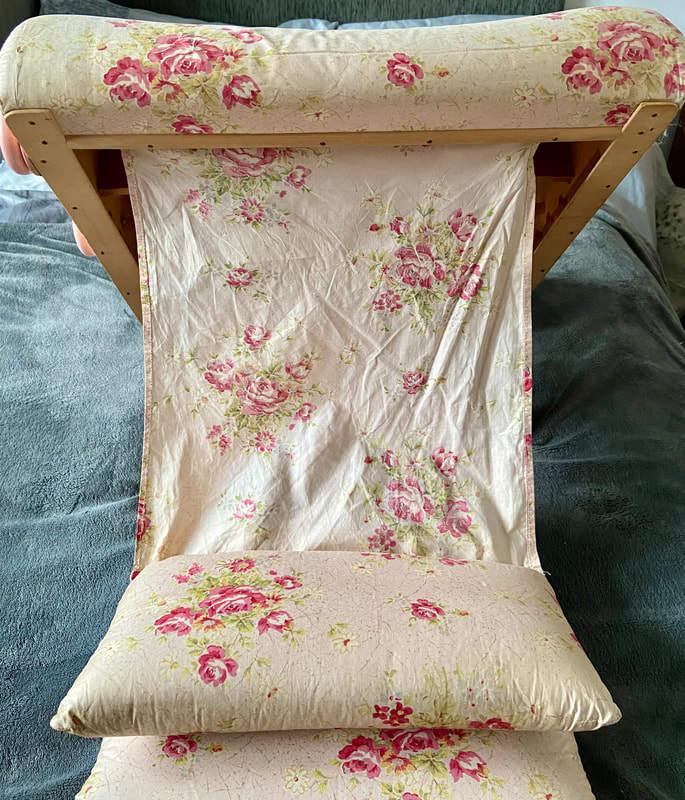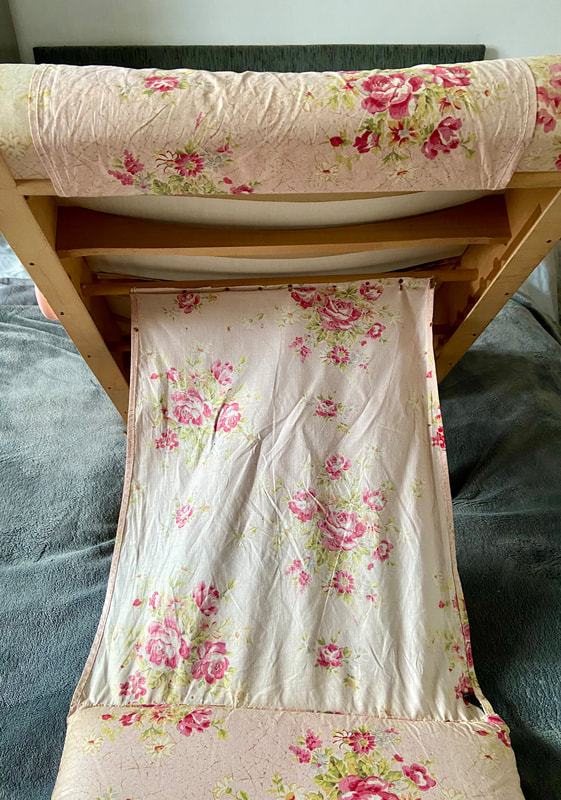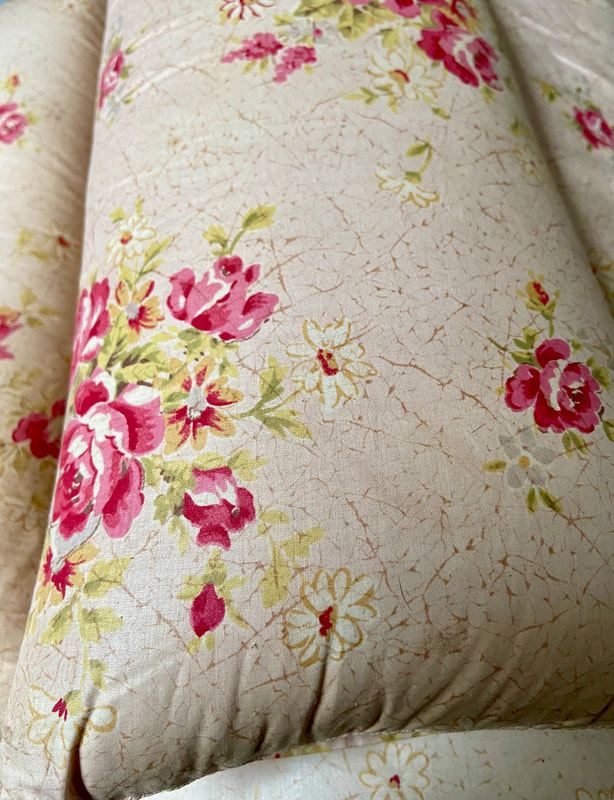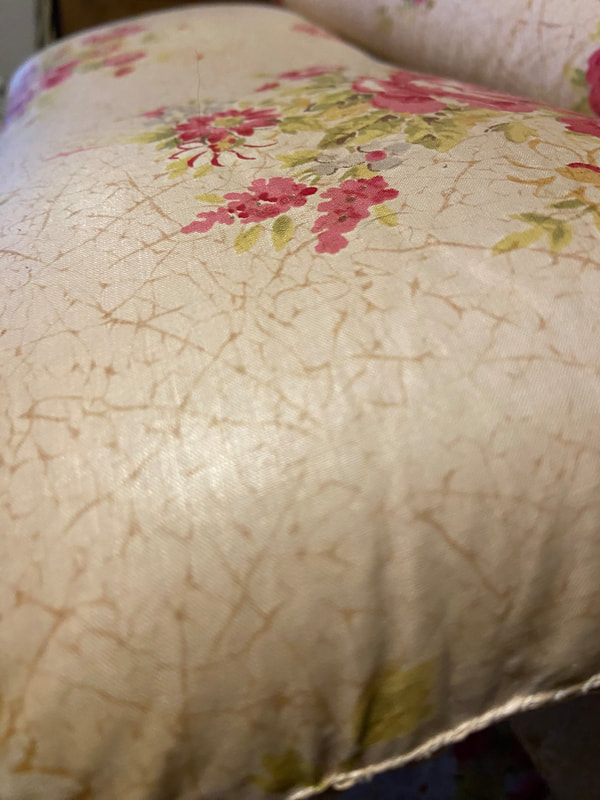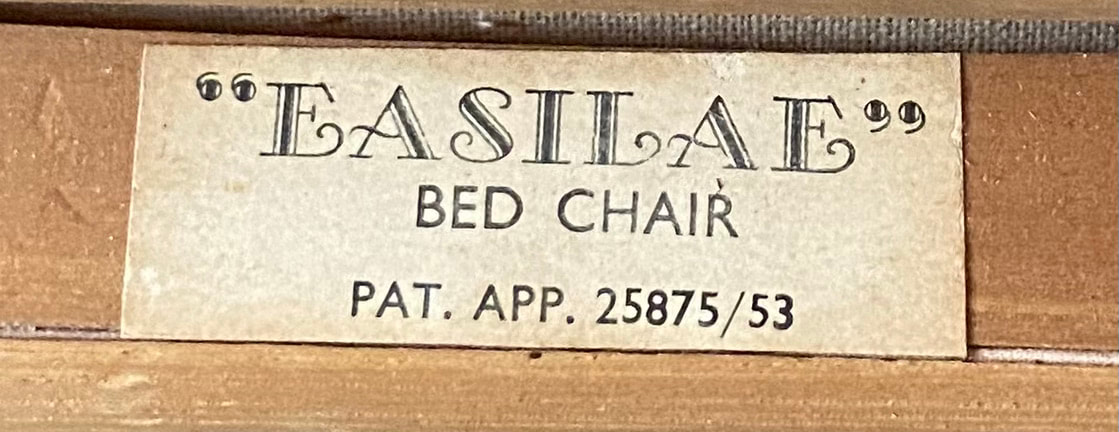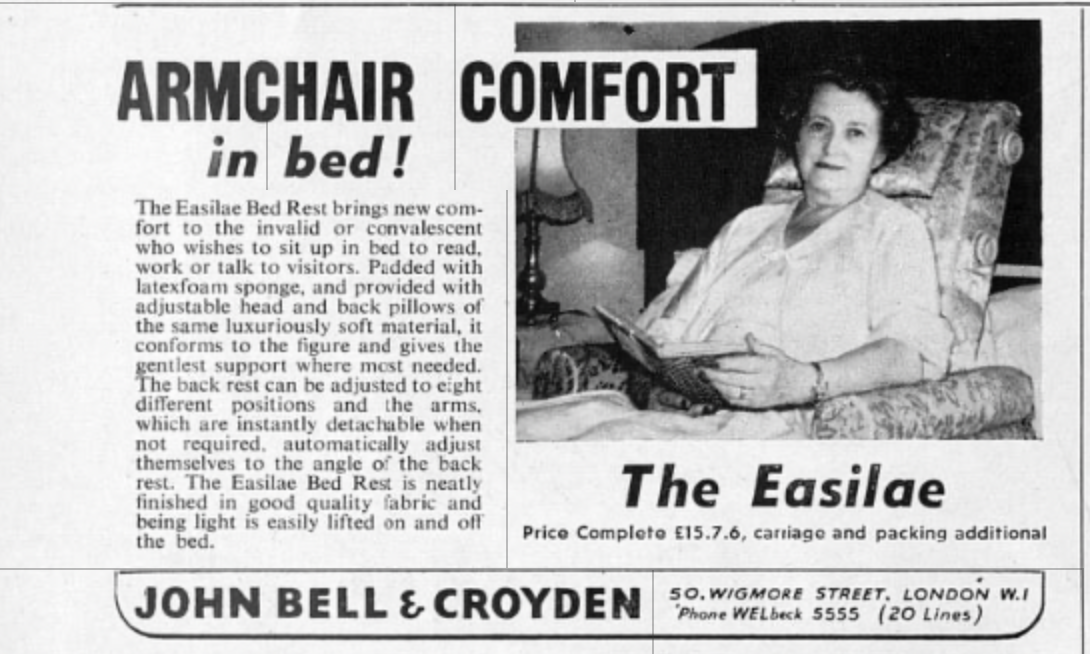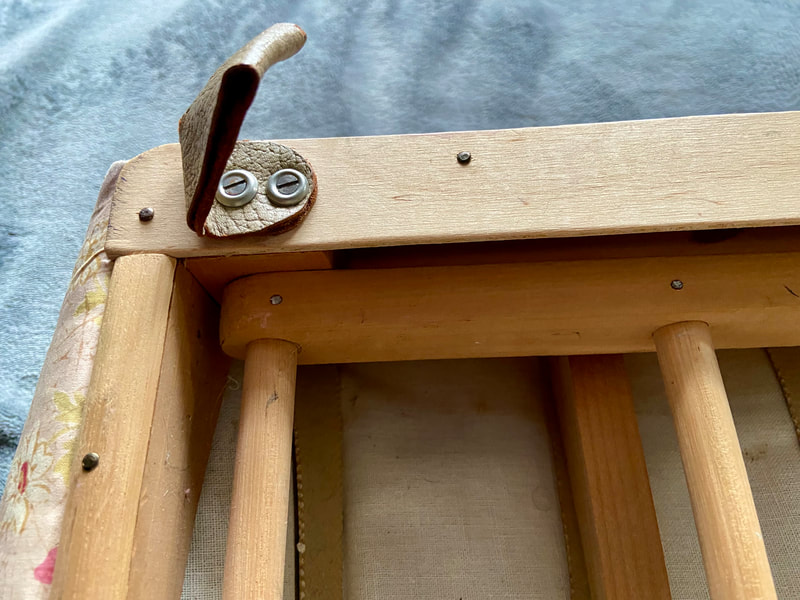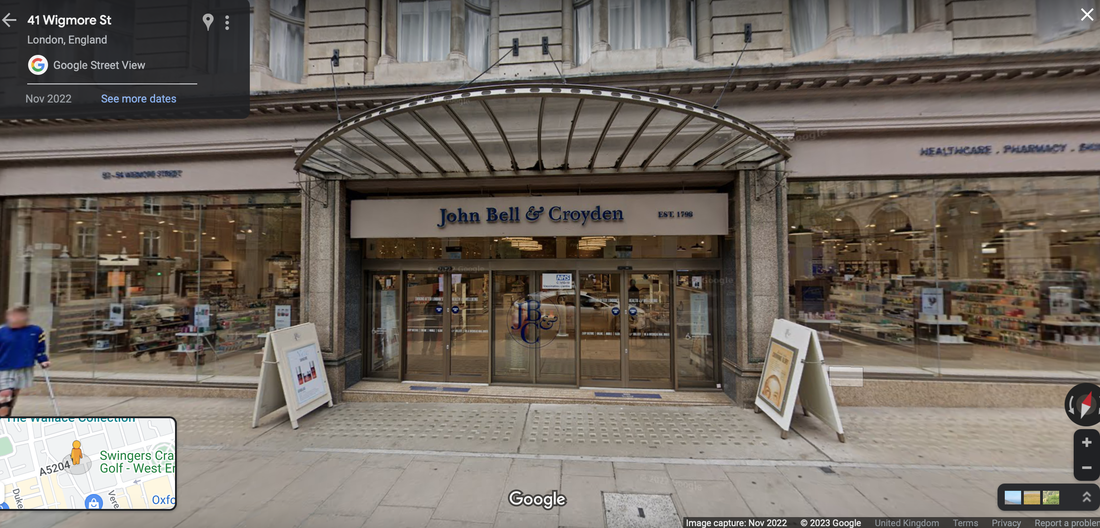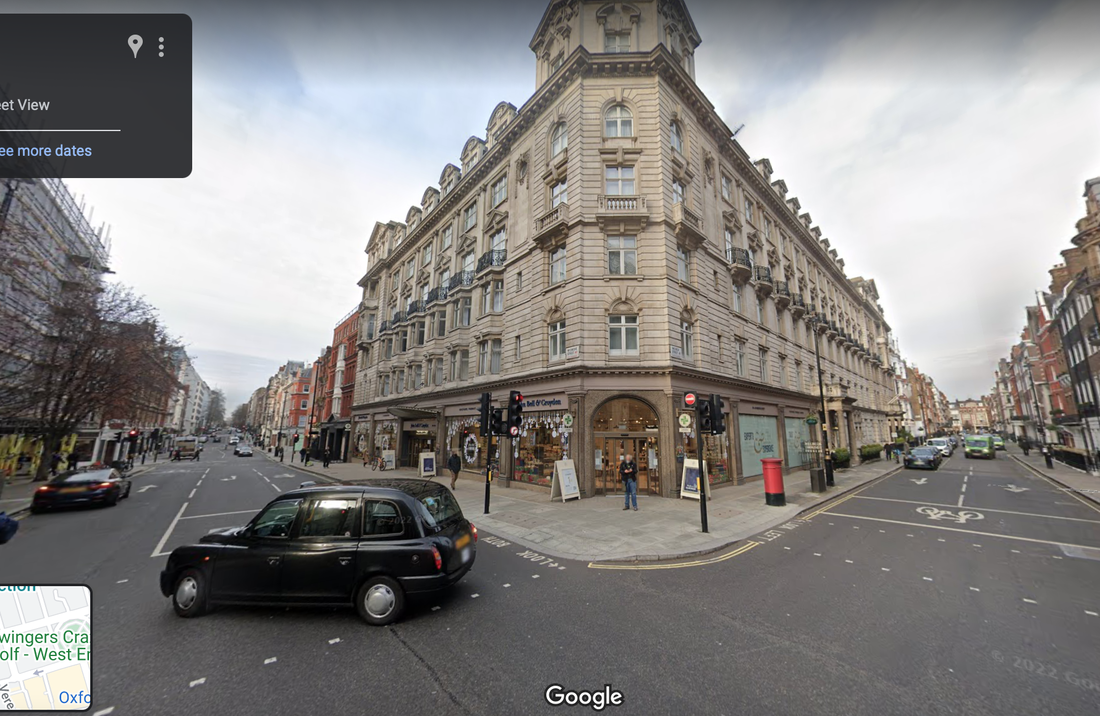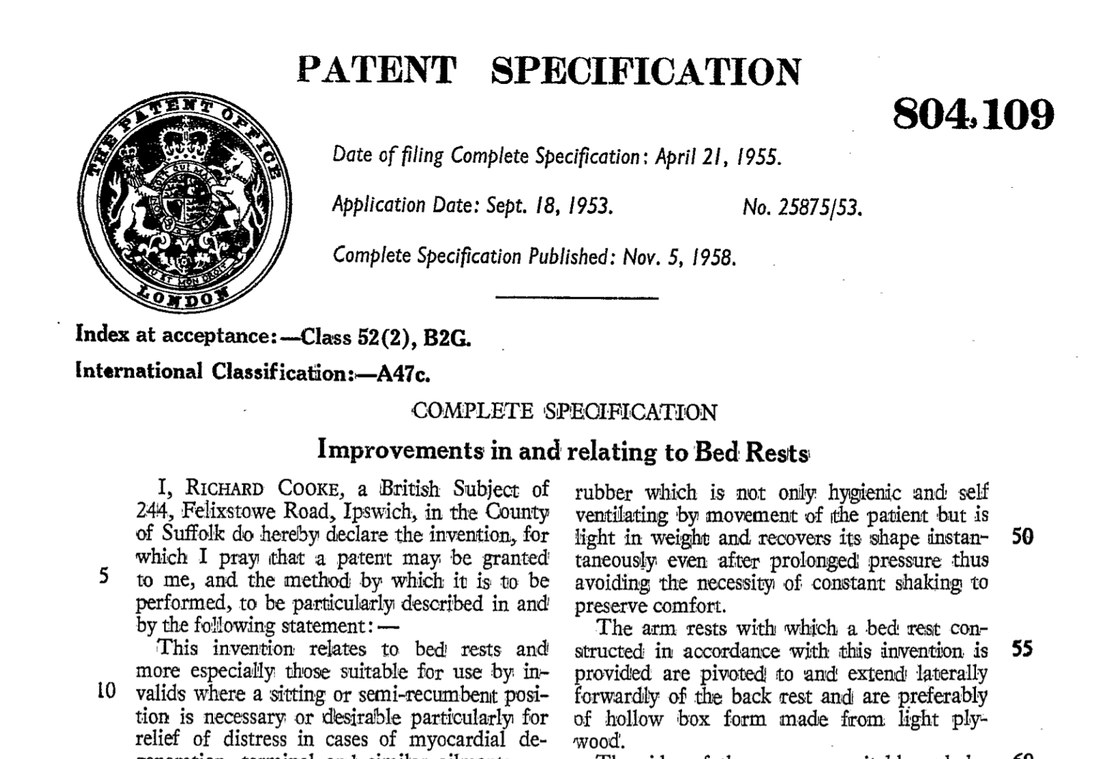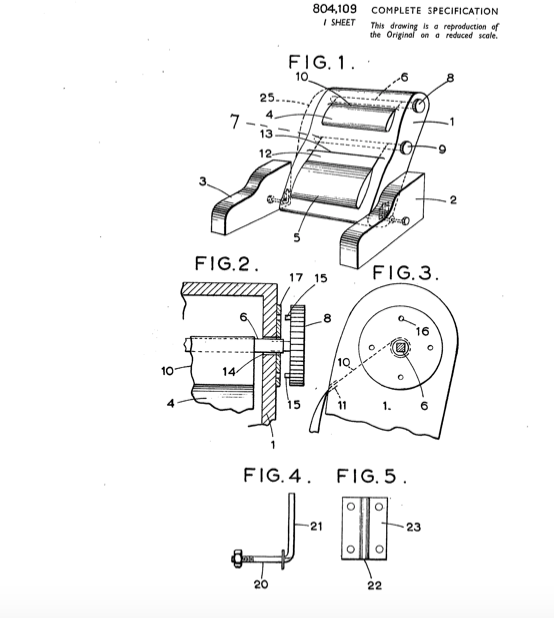|
My dear friend Sandra donated this interesting item. She got it some years ago in the 1990s from a charity shop in Cambridge. It looked to be from the 1940s or 50s and was an adjustable back rest - presumably made for sitting up in bed but it could also be used on a sofa or chair (we know, as we tested it and surprisingly comfortable it is too!). I have had this backrest for a while now and thought it was time to learn more about it. At first, we thought it could have been hand-made, but upon further inspection, there is a brand name and patent number on a small plate at the back base - we'll come to that in a minute.
The backrest is fully adjustable by the wooden frame on the back (it's a little like a deck chair in that regard). It can be folded down for easy storage when not in use.
On the left-hand side, there are two painted pink wooden knobs, which can be turned and set in place by the wooden pin, shown in the pictures below. These allow the position of the back frame to be set or adjusted.
The front is very padded and has two attached but movable flip-over cushions, which flip over from the back to the front as needed.
The material has a fine, strong, cotton feel and has a slight shine to it - almost like a silk blend. It is a pale pink hinted cream colour with a floral pattern.
On the back wooden brace, at the base of the bed chair, is this smart little product label. It states the "Easilae" brand name, the description of 'Bed Chair' and the Patent Applied for number.
So now we have a little more to go on and it is not a homemade item, it was manufactured. So, to find out more I started with a simple Google search to see if I could discover more about the item, the brand and how many Easilae's still survived. As it turned out, there was nothing online that I could initially find. Including via image search, eBay checks, museum pieces, general Googling....you name it but nothing!
This was intriguing as it is not often that these general searches come up with no leads at all.
I then turned my attention to searching the various databases that I use as a historian, which include the National Archives, various museum archives and all sorts. Still nothing!
Then I decided to search through the various newspaper archives because I figured that if this was an item that was for sale during the 1950s there may be an advertisement for it somewhere.
As luck would have it, I managed to find the one and only reference to the Easilae throughout the newspaper archives that I searched. It was a singular advert placed in the high society magazine The Tatler, in 1957.
And there it is! Our Easilae!
There are several things that we can learn from this advert. Firstly, it dates our item to around 1957. By looking at the picture in the advert we can see that the item looks identical, apart from, the one in the advert that looks as though it has arms. The advert states "..and the arms, which are instantly detachable when not required." Our Easilae does not have arms and when Sandra got it in the 1990's it didn't have arms with it. On the back of our one, there are leather loops on either side, which seem to have no function - see pictures below. These then must have been where the arms for the bed rest would have been attached originally. They would have probably been linked with a rod slotted through these two loops.
The advert states that the Easilae would cost £15.7.6 - as a rough guide, from the bank of England inflation calculator on their website, £15 in 1957 would cost about £287.59 today. So, the Easilae was not a cheap item to own.

We also learn from the advert that the vendor for the Easilae, in this instance, was John Bell & Croyden of 50 Wigmore Street, London. As we have so little else to go on it is worth having a look at this to see what we can find out.
A simple Google Street search of the address shows, that amazingly, the company, John Bell & Croyden, is still at the same address and still going strong!
John Bell & Croyden started as a pharmacy in 1798 and moved to its current site on Wigmore Street, London in 1912.
Given the advert, they must have stocked this bedrest chair - I wonder if this is where our item was purchased from? Was it ever stocked anywhere else? Who owned it and how did it end up in Cambridge? As always, these little bits of research produce so many more questions as one goes along. A visit to the John Bell & Croyden website gives a page about their history and can be visited here to read a little more: https://johnbellcroyden.co.uk/blogs/about-us/our-history-through-the-ages
Given the singular advertisement for the Easilae found so far and the only connection I have for it being sold anywhere is at the John Bell & Croyden store, I imagine that perhaps it only had a short run of success. I wonder how many were even sold? The lack of any Easilae to be found online - either for sale on sites such as eBay or in museums, makes me wonder how many even survived and that we may have one of the only remaining ones!
Let's return to look at the label on the item for any remaining clues.
The label gives a patent applied for number: 25875/53
A search for the Patent on Espacenet (the place to go for Patents from 1890 onwards), reveals that the applicant for the patent was Richard Cooke, a British Subject of 244 Felixstowe Road, Ipswich, Suffolk.
The patent gives the full details of the purpose, use and construction of the bed rest. You can see a partial picture of the original patent below and if you would like to see the full patent, I have added the PDF of the document, below the picture, so that you can open that and have a read.
Here is an original drawing from the patent of the Easilae bed chair.
Again, we can see from both the 1957 advert and this patent that the Easilae would have originally had detachable armrests which we do not have. They must have been lost over the years.
The applicant date for the patent was 18th Sept 1953. The date of filing the patent was 21st April 1955 the complete specification was published on 5th Nov 1958. Our Easilae has the label stating 'patent applied' for, indicating that it dates from before the patent was granted - which was in Nov 1958. The advert for the Easilae above is Nov 1957, before the patent was granted, so any sold at this point would have the Pat. App. (Patent applied for) label. This firmly dates our Easilae to pre-Nov 1958.
The next thing to do is to see if we can find out anything else about the inventor of the Easilae. Nothing immediate was coming up for Richard Cooke on a general Google search. Let's start by finding his house at 244 Felixstowe Road, Ipswich. Here is a Google street view of what was Richard Cooke's house from at least 1953-1958 (as stated in the patent). 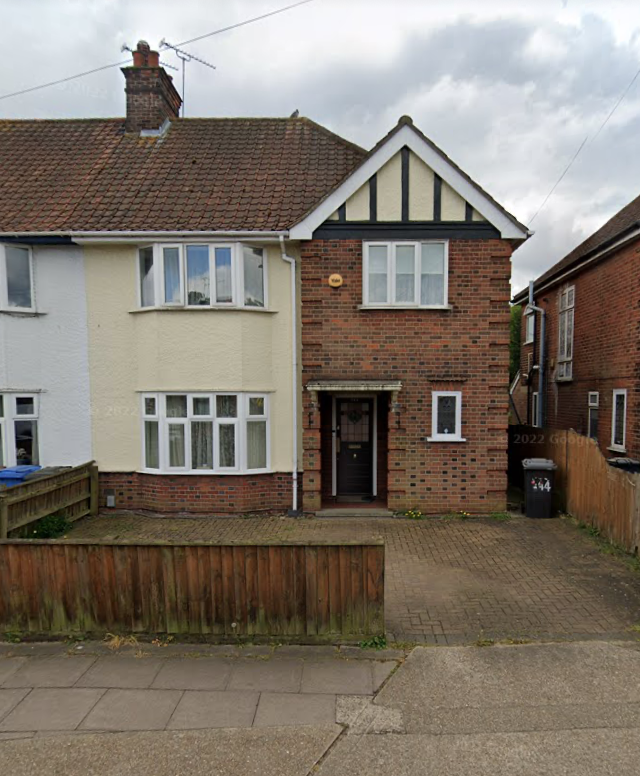
I wonder if Richard was someone who generally invented things already, what his job was or if he had had to care for someone and this is how the Easilae came about?
I spent a good deal of time searching through all of my various archives and databases, I also turned to Ancestry and the many various other records sites but I could find nothing that firmly linked to Richard Cooke at this address nor anything else about him. I did find a record of probate for Charlotte May Asbury of the same address, who had died in 1936. This would indicate that Richard Cooke would have been at this address after this date.
So, Richard Cooke would have been at the address after 1936 and we know he was there in 1953, 1955 & 1958.
I searched for him through all sorts of records, including Companies House and trade mark searches too but still nothing! Most unusual, for me at any rate, not to find out more. The only other inventor named Richard Cooke that I found was a chap who had invented an automatic cut-off for gas burners in 1908 and who was a British subject living in the states. It is a tenuous link but the only possible slim clue. Here is the entry below:
RICHARD H. COOKE, OF BUFFALO, NEW YORK.
AUTOMATIC CUT-OFF FOR GAS-BURNERS. No. 891,670. Specification of Letters Patent. Patented June 23, 1908. Application filed March 23, 1907. Serial No. 364,041. To all w7tom it may concern: Be it known that I, RICHARD H COOKE, a subject of the King of Great Britain, residing at Buffalo, in the county of Erie and State of New York, have invented a new and useful Improvement in Automatic Cut-Offs for GasBurners, of which the following is a specification.
Although very unlikely to be our Richard Cooke, it does lend to the idea that the lack of any leads so far on our Richard could be because he had lived abroad either before or after his stay in Ipswich. I have checked many overseas records but to no avail at present.
So, for now, at least, we will leave the Easilae research here and see what else may turn up in time. Perhaps you may be able to find out something more? Perhaps you were a relative of Richard Cooke or lived in the house in Ipswich at some point? You might have even seen an Easilae before or maybe still have one yourself.
Please do feel free to leave a comment below or get in touch using the 'Contact Me' form if you have any further information that can be added to this tale.
If you'd like to support the historical community work that I do you can donate by making a one-of donation at PayPal or via Buy Me a Coffee (it's like a tip jar). Just click on one of the choices below and I'd be very grateful :)
0 Comments
|
UK History Pages:
Contents If you'd like to go straight to a specific article or blog post within the Cambridgeshire History Pages you can click on any of the post titles in the list below and it will take you directly there. Alternatively, you can use the search box above to search by keyword or you can use the index further below. Virtual Museum. The Easilae - 1950s Vintage Bed Rest / Bed Chair.
Museum of Oxford, Rewind Time with History Needs You Exciting Old Photograph Album Lillie Langtry, London and Cambridge Home Front War Letters from Nottingham WWII George & Marie Cruden Home Front War Letter from Nottingham WWII Marie Cruden Home Front War Letter from Nottingham WWII Home Front War Letters from London WWII Cruden Family Home Front War Letters from Nottingham 1941 WWII Home Front War Letters from Nottingham WWII Nottingham Home Front War Letters WWII Home Front Letters from Nottingham WWII London WWII Home Front Letter Nottingham WWII Home Front Letter The Adventures of a Livery Button About & how to use:This is a blog page for the archives in my own collection. It includes many of my personal & family archives, tales and scrapbook items to all kinds of general archive items from UK History. The Categories below are really the keyword index of what is on the UK History Pages. Each is a clickable link which will take you to an article or blog which contains that word or subject.
Categories
All
Archives |
||||||
